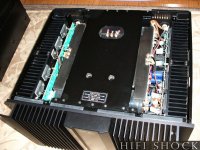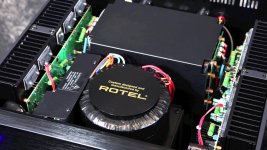I'll be taking possession of a couple of Rotel RB-1590 power amps shortly, to drive 4 passive subs (2 subs per stereo amp).
Each sub houses a 4-Ohm dual voice coil driver. So, I can configure the subs as either 2-Ohm or 8-Ohm loads.
Hifi News measured the RB-1590's dynamic output as follows:
- 565W into 8 Ohms
- 870W into 4 Ohms
- 455W into 2 Ohms
- 235W into 1 Ohm
So clearly, I will configure the subs as 8-Ohm loads.
But I'm curious...
Although the amplifier is capable of outputting around 50A, Rotel use a current-limiting circuit to limit the current to only 15A max.
I understand that the current-limiting circuit will protect the amp should a short occur.
But did Rotel really need to 'throttle' the amp so badly?
All thoughts welcome.
Mani.
Each sub houses a 4-Ohm dual voice coil driver. So, I can configure the subs as either 2-Ohm or 8-Ohm loads.
Hifi News measured the RB-1590's dynamic output as follows:
- 565W into 8 Ohms
- 870W into 4 Ohms
- 455W into 2 Ohms
- 235W into 1 Ohm
So clearly, I will configure the subs as 8-Ohm loads.
But I'm curious...
Although the amplifier is capable of outputting around 50A, Rotel use a current-limiting circuit to limit the current to only 15A max.
I understand that the current-limiting circuit will protect the amp should a short occur.
But did Rotel really need to 'throttle' the amp so badly?
All thoughts welcome.
Mani.
A service manual or schematic would be helpfulAny thoughts on this???
A service manual or schematic would be helpful
Unfortunately, I don't have one and can't find one online.
But anyway, my question was more related to the reasoning behind limiting the output current to such an extent, rather than the implementation. As I mentioned, the amplifier is capable of outputting 50A.
Hifi News measured the RB-1590's dynamic output as follows:
- 565W into 8 Ohms -> 8.4A 67.23V
- 870W into 4 Ohms -> 14.75A 58.99V
- 455W into 2 Ohms -> 15.08A 30.17V
- 235W into 1 Ohm -> 15.32A 15.33V
Therefore the power supply rails could be 67.23V x 1.41 + 3V = 97.80 , lets say rails are 100V and -100V
peak current trough load is about 15.32 x 1.41 = 21.6A
With that, the power would be 5000 W ; even if let say at full power rails go from 100V down to 70V it would be still 3500WAs I mentioned, the amplifier is capable of outputting 50A.
looking at this, I start having doubts that 50A is possible
Secondly, If I check the Rotel website:
- POWER CONSUMPTION is just 800W (2 x 350 Watts stereo amplifier)
- from the pictures, I can see on one of the transistors written 2SC3264 which has maximum voltage 230V (about right to pick a transistor with 230V if the power rails are + - 100V, or in other words 200V difference) and maximum current 17A. So definitely to get the peak current 21.6 A there should be at least 2 in parallel. Without a schematic, I am not sure where that transistor is used and how many are in parallel, or if the limitation is arbitrary (the designer thoughts could have been: let's put 2 transistors of 17A in parallel and due to components dispersion one transistor can get 30% more current than the other therefore he considered safe to limit the total current to 21.6 A ?!?). Maybe there are 4 transistors in parallel and then 50A output is possible from the transistors' point of view, and if that is the case the current limit could be there to not exceed the maximum output of the supply transformers (also bridge rectifier and capacitors maybe) or maximum power (heat) dissipation on transistors and/or transformers. Without the schematic is just guessing.
Last edited:
looking at this, I start having doubts that 50A is possible
Apparently, Rotel has measured an RB-1590 with the current-limiting circuit removed, and it delivered 1500W into 2 Ohms, and 2400W into 1 Ohm.
I'm trying to understand why the decided to throttle it as much as they have into low impedances.
Mani.
Running that amplifier at 50A output current for more than a few milliseconds is a sure way to get the output transistors to self destruct. Don't forget that the supply transformers also need to be able to supply that amount of current, which they won't for very long without fusing. If the transformers can supply 800 watts, then that is the maximum continuous power (less the maximum efficiency factor for class AB) available, regardless of what the load impedance is. Also the dissipation in the output transistors will rise with lower impedance loads, so the heatsinks will run out of capacity very quickly. Designing the power supply, output stages and heatsinks for delivering continuous power into 1Ω would quadruple the engineering cost compared designing for continuous power into 4Ω, and for what purpose? Such a specification isn't relevant to 99.99% of Rotel customers.
Like most manufacturers of consumer audio equipment, Rotel most likely just made up those numbers. The most outrageous I have ever seen was a Sony ghetto-blaster loudly and proudly emblazoned with a sticker claiming 22,600 watts output. Fortunately the Sony had a figure-8 power lead with ~0.5mm² conductors, which would have fused long before the house electrical system caught fire.Apparently, Rotel has measured an RB-1590 with the current-limiting circuit removed, and it delivered 1500W into 2 Ohms, and 2400W into 1 Ohm.
My understanding is that the RB-1590 is based on the older Rotel RB-1090 (for which schematics are readily available online). The latter had 2x 1.25KVA transformers. Stereophile measured the RB-1090 as outputting 2825W into 1 ohm (toneburst into one channel): https://www.stereophile.com/content/rotel-rb-1090-power-amplifier-measurements.
Who needs this sort of power in a domestic setting? Certainly not me. BUT... I'm still curious as to why Rotel throttled the later RB-1590 as much as they did. The older RB-1090 on which it's based didn't seem to be.
Who needs this sort of power in a domestic setting? Certainly not me. BUT... I'm still curious as to why Rotel throttled the later RB-1590 as much as they did. The older RB-1090 on which it's based didn't seem to be.
It is clear from the Stereophile measurements that the practical output of the 1090 is ~350w/8Ω and 700W/4Ω. With tone burst measurement all that has to be done is to set the tone burst duration short enough that the supply rails don't droop. The output current limiting is too slow to come into play under these circumstance. If the 1590 was tested using the same tone burst measurements it would most likely produce similar results, and that measurement would be just as meaningless as the Stereophile results for the 1090. BTW to produce 700W with class AB requires about 1.2kW out of the transformer.
It is clear from the Stereophile measurements that the practical output of the 1090 is ~350w/8Ω and 700W/4Ω. With tone burst measurement all that has to be done is to set the tone burst duration short enough that the supply rails don't droop. The output current limiting is too slow to come into play under these circumstance. If the 1590 was tested using the same tone burst measurements it would most likely produce similar results, and that measurement would be just as meaningless as the Stereophile results for the 1090. BTW to produce 700W with class AB requires about 1.2kW out of the transformer.
Ah, OK. Thanks for your explanation.
- from the pictures, I can see on one of the transistors written 2SC3264 which has maximum voltage 230V (about right to pick a transistor with 230V if the power rails are + - 100V, or in other words 200V difference) and maximum current 17A. So definitely to get the peak current 21.6 A there should be at least 2 in parallel. Without a schematic, I am not sure where that transistor is used and how many are in parallel, or if the limitation is arbitrary (the designer thoughts could have been: let's put 2 transistors of 17A in parallel and due to components dispersion one transistor can get 30% more current than the other therefore he considered safe to limit the total current to 21.6 A ?!?). Maybe there are 4 transistors in parallel and then 50A output is possible from the transistors' point of view, and if that is the case the current limit could be there to not exceed the maximum output of the supply transformers (also bridge rectifier and capacitors maybe) or maximum power (heat) dissipation on transistors and/or transformers. Without the schematic is just guessing.
Thanks for your thoughts.
Just FYI, the RB-1590 seems to have 4 transistors per channel (2x 2SA1295, 2x 2SC3264).
I am not knocking the 1590 or Rotel, just trying to restore perspective.Ah, OK. Thanks for your explanation.
There you go: Each have 17A max current, in a theoretically perfect parallel connection of 2, you can have max 34A (less than claimed 50A). If you want to design a reliable product you don't go up to 17A, you stay preferably way under 15A peak current per transistor.the RB-1590 seems to have 4 transistors per channel (2x 2SA1295, 2x 2SC3264).
If you want to play with fire, you can add a 2.2 kohms resistor in RB-1590 in parallel with each of the equivalent of R764 and R768 (1kohm) from RB-1090 (see attached RB-1090 picture, 2 resistors in red per channel, both 2k2). This is based on RB-1090, schematic, resistor values and schematic could be different in RB-1590, do it at your own risk, you may destroy your amplifier! I picked 2.2kohms value in parallel with the exiting 1kohm for an increase from15A to about 20A in the protection current (again based on assuming RB-1590 schematic and resistor values are the same as in RB-1090 schematic, only having 2 transistors in parallel instead of 4 in the final stage!).My understanding is that the RB-1590 is based on the older Rotel RB-1090 (for which schematics are readily available online).
Attachments
Last edited:
If you want to play with fire...
Haha... no thanks.
... (again based on assuming RB-1590 schematic and resistor values are the same as in RB-1090 schematic, only having 2 transistors in parallel instead of 4 in the final stage!).
The final stage of the RB-1590 should be very similar, if not identical, to the RB-1090. Their ouput powers are virtually identical:
- RB-1590 (as measured by Hifi News): 490W/805W (8/4 Ohms)
- RB-1090 (as measured by stereophile): 437W/~800W (8/4 Ohms)
Based on those numbers the power supply for the older 1090 is 'stiffer' than that of the 1590, which if as good would produce 897W into 4Ω. In any case, I'm not sure how similar power outputs implies anything about similarity of the final stages of the two.
- Home
- Amplifiers
- Solid State
- Rotel RB-1590


